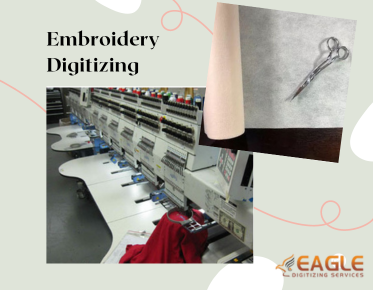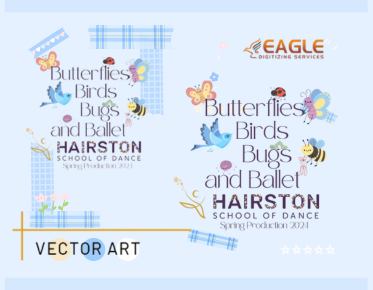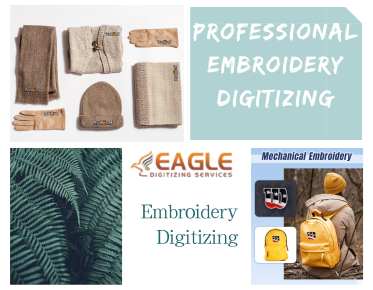How does an embroidery machine do stitching?
Unraveling the Magic Behind the Stitches
Embroidery has long been a revered craft, weaving beauty into fabrics
with each intricate stitch. But in today’s world, technology has breathed new
life into this ancient art, transforming the way we createstunning designs. Enter the embroidery machine—a game-changer that
brings precision, speed, and creativity to the forefront of textile artistry.
In this article, we’ll explore the wonders of embroidery machines, diving into
the technology, process, and magic behind the stitches.
Why embroidery machines are
game-changers in the world of textile art
Embroidery machines have revolutionized the textile industry in ways
unimaginable just a few decades ago. Once considered an intricate,
time-consuming handcraft, embroidery is now a swift, automated process, making
it accessible to both seasoned artists and beginners alike. These machines have
not only increased the volume of designs produced but have also made it
possible to achieve levels of detail and precision that would be nearly
impossible with hand stitching alone. The ability to replicate complex patterns
effortlessly means that artists can focus more on creativity, while the machine
handles the technical aspects. From custom clothing to intricate home décor,
embroidery machines have opened new doors to arti stic expression.
The evolution of embroidery:
From handwork to high-tech
The journey from hand-stitched to
machine-stitched embroidery is a tale of both tradition and innovation. For
centuries, embroidery was a painstaking handcraft, requiring skill and patience
to achieve even the simplest of designs. In the early 19th century, the first
sewing machines revolutionized the textile industry, and by the mid-20th
century, advancements in electronics and computer technology paved the way for
the embroidery machines we use today. What once took hours or even days to
complete now takes mere minutes. The evolution from handwork to high-tech
stitching represents a perfect fusion of artistic tradition and modern
ingenuity, where the hand of the artist meets the precision of technology.
The Basics: What Is an Embroidery Machine?
An embroidery machine is essentially a specialized sewing machine
designed to create decorative designs on fabric using thread. It operates using
a series of threads, needles, and hoops, all controlled by a computer or
digital interface. These machines can produce a wide range of stitches, from
simple to highly intricate, allowing users to recreate anything from small
logos to large, detailed works of art. The embroidery machine simplifies what
would traditionally be a labor-intensive and skill-dependent process, offering
a faster and more efficient way to create beautifully detailed designs.
Understanding the components
that make it tick
An embroidery machine is made up of several key components, each
playing a crucial role in bringing your designs to life. These include the
needle, bobbin, thread tension system, hoop, and embroidery head, which holds
the needle and thread in place. The embroidery machine also
includes a motor to drive the movements and a computer or software interface
that reads the digital design and directs the machine to follow precise
stitching paths. Together, these elements work harmoniously to ensure the
machine operates with precision and accuracy.
A quick tour of the embroidery
machine's anatomy
Picture the embroidery machine as a carefully orchestrated symphony.
The needle is the lead musician, performing the intricate dance of creating
stitches. The bobbin and upper thread provide the raw materials for these
movements, while the hoop ensures that the fabric stays taut, maintaining the
integrity of the design. The computer system acts as the conductor,
orchestrating the machine’s actions, reading the design file, and translating
it into a series of precise movements. When all components are in sync, the
result is a flawless piece of embroidered art.
Loading the design: Translating
art into stitch
Loading a design into an embroidery machine is like giving the machine
a blueprint for the masterpiece it is about to create. Designs are usually
loaded through a USB, computer connection, or wirelessly, depending on the
machine. Once the design is transferred, the machine’s computer system reads
it, breaking it down into commands that tell the needle when and where to
stitch. This digital translation allows the machine to replicate even the most
complex designs with impressive accuracy.
Choosing the right fabric and thread for your masterpiece
Selecting the correct fabric and thread is essential for achieving the
best possible outcome. Fabrics such as cotton, linen, or denim are popular
choices, as they hold the stitches well. The weight and texture of the fabric
will dictate the type of thread used—whether you opt for cotton, polyester, or
specialty threads like metallic or variegated. Choosing the right materials
ensures the design is not only beautiful but durable too.
Decoding the Software: How Your
Machine Reads Designs
Embroidery software is the silent orchestrator behind the entire
embroidery process. Think of it as the translator between your design’s
artistic vision and the machine’s mechanical actions. When you upload a design
into the embroidery machine, it is the software that breaks down this artwork
into a set of instructions, effectively transforming the design into something
the machine can interpret. This involves turning the design into a series of
“paths” that tell the machine exactly where to place each stitch when to switch
threads, and what stitch types to use for different sections of the design.
Winding the Bobbin: The Secret Behind Perfect Tension
Winding the bobbin properly is essential to this balance. If it’s
wound too loosely, the thread may not have enough tension, leading to loose
stitches or missed ones. If it’s too tight, the thread could snap or create
uneven tension, causing the stitches to pull at odd angles. The bobbin sits
under the fabric while the needle delivers the upper thread to form the stitch.
As the needle moves, the bobbin draws the lower thread into place, completing
each stitch. The precise balance between these threads ensures smooth, even
stitching throughout the entire design.
Setting
Up the Upper Thread: A Crucial First Step for Smooth Stitching
While the bobbin plays its part below the surface, the upper thread is
just as crucial in ensuring a smooth, flawless stitch. Properly loading and
tensioning the upper thread is a delicate task that can make or break your
design. The upper thread is responsible for creating the majority of visible
stitches, and if it’s improperly threaded, the results can be disastrous.
Snags, uneven lines, and loose stitches are all common issues caused by thread
tension problems.
Exploring the Needle and Its Precision Movement
At the heart of the embroidery process lies the needle—an incredibly
precise tool that moves with exceptional accuracy. Unlike a regular sewing
machine, the needle in an embroidery machine doesn’t just move up and down in a
simple vertical motion. Instead, it follows a carefully calculated path,
controlled by the machine’s computer, which dictates exactly where the needle
should go at any given moment. This allows the machine to create everything
from simple lines to intricate curves and even detailed shapes.
The Intricate Dance: How the Machine Knows When and Where to Stitch
Think of the machine’s movement as a perfectly coordinated dance. The
embroidery machine reads the design file, analyzing the pattern’s paths and
determining where the needle should go next. Every move is calculated and
executed with millimeter-level accuracy, ensuring that the design is reproduced
exactly as intended.
This “dance” involves multiple stitch types, each of which requires
its own set of instructions. A straight stitch requires one kind of movement,
while a satin stitch requires a more controlled, delicate approach. The machine
not only needs to know when to switch between stitch types but also when to
pause for thread changes, making the stitching process an incredibly intricate
performance. The software decodes every single detail, mapping out the needle’s
path with unparalleled precision.
Auto-Thread Cutting: The Unsung Hero of Clean, Tidy Finishes
Another game-changing feature of embroidery machines is the automatic
thread-cutting function. Once a design is completed, or when a thread color
change is needed, the machine automatically cuts the thread at the perfect
moment. This feature ensures that your project remains neat, with no excess
thread ends to trim manually.
Automatic thread cutting isn’t just about saving time—it also ensures
a clean, professional finish. Without it, you might find yourself with loose
threads or uneven cuts, which can detract from the final appearance of the
embroidery. By cutting the thread at the optimal point, the machine ensures
that the design is crisp, clean, and ready to be showcased without any
additional trimming or fuss.
Straight Stitches, Satin Stitches, and More: A Stitch for Every Occasion
The variety of stitches available on an embroidery machine is one of
the reasons why these machines are so versatile. Straight stitches are the
bread and butter of many designs, forming the foundation for both simple and
complex patterns. These basic stitches are used for outlining, defining edges,
and creating solid lines.
Satin stitches, on the other hand, are perfect for creating
smooth, dense lines, ideal for filling large areas with color. The beauty of
satin stitches lies in their ability to cover a wide space while maintaining a
smooth finish. But straight and satin stitches are just the beginning.
Embroidery machines offer a wide range of other stitches, from fill stitches
that create solid backgrounds to running stitches that add delicate texture to
designs. Each stitch type serves a specific purpose, allowing designers to add
depth, texture, and visual interest to their creations.
Specialty
Stitches: How Machines Replicate Complex Designs
For more intricate designs, embroidery machines can replicate complex
specialty stitches, elevating the possibilities even further. Techniques like
cross-stitch, French knots, and appliqué, once painstakingly completed by hand,
can now be achieved with remarkable precision. Cross-stitch, with its X-shaped
stitches, can be used to create pixelated designs, while French knots add
texture and dimension to floral patterns or delicate details.
Appliqué is another specialty stitch that has been brought into the
realm of machine embroidery. This technique involves sewing a piece of fabric
onto the base material, creating a layered effect. The embroidery machine can
stitch around the edges of the fabric, ensuring that the appliqué stays
securely in place while maintaining clean, even lines.
Fixing
Thread Breaks: What to Do When Things Go Wrong
Thread breaks are a common issue in embroidery, but they can usually
be resolved quickly with a few adjustments. Most thread breaks are caused by
tension problems—either the upper thread is too tight or the bobbin is
improperly wound. A dull needle or poor-quality thread can also cause breakage.
The first step to fixing a thread break is to ensure that the machine is
properly threaded, with both the upper and lower threads securely in place.
Once you’ve checked the tension and thread quality, it’s important to
identify the root cause of the problem. If the bobbin is too tight, re-wind it
with a looser tension. If the needle is dull, replace it with a fresh one.
These simple steps can prevent thread breaks and keep your embroidery running smoothly.
Dealing
with Needle Issues: Ensuring Smooth Stitching Every Time
The needle is a critical component of the embroiderymachine, and any issues with it can lead to poor stitching. Needles can
become dull or bent over time, which can cause skipped stitches or uneven stitching.
Additionally, thread buildup can clog the needle, causing it to drag or skip
parts of the design.
Regularly checking and replacing the needle ensures that your machine operates at peak performance. If you notice any issues with stitching quality, it’s always a good idea to check the needle first. By keeping it sharp and clean, you’ll ensure that the stitching remains smooth, consistent, and precise throughout the entire project.



